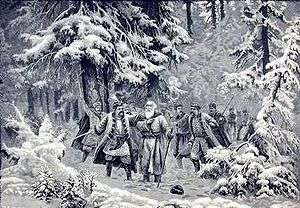Ivan Susanin

Ivan Susanin (Ива́н Суса́нин) (died 1613) was a Russian national hero and martyr of the early 17th century's Time of Troubles.
Evidence
In 1619, a certain Bogdan Sobinin from Domnino village near Kostroma received from Tsar Mikhail one half of Derevischi village. According to the extant royal charter, these lands were granted him in reward for his father-in-law's refusal to reveal to the Poles the location of the tsar's family. The latter's name was given as Ivan Susanin.
Subsequent charters (from 1641, 1691, and 1837) diligently repeated the 1619 charter's phrases about Ivan Susanin being "investigated by Polish and Lithuanian people and subjected to incredible and great tortures in order to learn the great tsar's whereabouts but, though aware about that and suffering incredible pains, saying nothing and in revenge for this being tortured by Polish and Lithuanian people to death".
In the early 19th century the charters attracted attention of nascent Russian historiography and Ivan Susanin was proclaimed a Russian national hero and a symbol of Russian peasants' devotion to the tsar. He was officially promoted as a national hero, and commemorated in poems and operas, such as Mikhail Glinka's A Life for the Tsar.[1] Gradually, there evolved the following legend about Ivan's life and death.
Legend
The village of Domnino used to be owned by Xenia Shestova, wife of Fyodor Romanov and mother of Mikhail Romanov. Upon the latter's election to the Russian throne in 1613, the Zemsky Sobor sent Prince Vorotynsky and several other boyars to inform Mikhail, then living in Domnino, about his election.

There were many Polish detachments still roaming Russia, however. They supported Sigismund III Vasa, who refused to accept defeat and still laid claim to the Russian throne. One of these discovered the news and sent troops to Kostroma to find and kill the young tsar.
It is said that they did not know the road to Domnino very well, so they started to ask the locals for directions. In woods near the village they met a logger, Ivan Susanin, who promised to take them via a "shortcut" through a forest directly to the Hypatian Monastery, where Mikhail apparently was hiding. The enemies followed him and were never heard from again. It is presumed that Susanin led them so deep into the forest that they could not find a way out, and they perished in the bitter cold February night.
Susanin's son-in-law, whom Susanin secretly sent ahead via a different route, warned Mikhail Romanov, and the monks concealed him from further Polish raids. Mikhail was crowned tsar and ruled Russia for 32 years, founding the Romanov dynasty.
Legacy

Stories and images of Ivan Susanin as an iconic Russian patriot inspired many artists, composers, and writers, especially in the Russian Empire. Kondraty Ryleyev glorified Susanin's exploits in a poem. Mikhail Glinka wrote one of the first Russian operas of international renown, "Ivan Susanin" (aka "A Life for the Tsar"). The opera saw several name changes. The original title of the opera was to be "Ivan Susanin", after the hero, but when Nicholas I attended a rehearsal, Glinka changed the title to "A Life for the Tsar" as an ingratiating gesture. This title was retained in the Russian Empire until the Russian Revolution, when it reverted to "Ivan Susanin". The opera's openly monarchist libretto was edited to comply with Soviet ideology. The Tsar's anthem melody on Tchaikovsky's 1812 finale was in turn replaced by the chorus "Glory, glory to you, holy Rus'!", Славься, славься, святая Русь! from Glinka's Opera.[2]
In 1838, Nicholas I ordered a monument built to Susanin in Kostroma, but this was destroyed by the Bolsheviks, who were offended by the tsar's statue which the monument incorporated. Later they erected another monument to the hero.
Nikolay Kostomarov, a historian opposed to Nicholas's regime, was the first to raise the issue of the legend's doubtful historicity. He was nonplussed by the fact that it was in the Ipatiev Monastery and not in the village of Domnino that Mikhail Romanov was residing in 1612. His arguments were dismissed by the more orthodox scholars, such as Mikhail Pogodin and Sergey Solovyov.
The name "Susanin" has become an ironic cliché in the Russian language for a person who leads somewhere claiming to know the way, but who eventually proves not to.
Glinka's play A Life for the Tsar was featured heavily throughout the Romanov tercentenary celebrations. It was performed in a gala performance at Marinsky Theatre,[3][1] Performances of A Life for the Tsar was staged throughout Russia by schools, regiments and amateur companies. Pamphlets and the penny press printed the story of Susanin ad nauseam, and one newspaper told how Susanin had showed each and every soldier how to fulfill his oath to the sovereign. At the bottom of the Romanov Monument in Kostroma, a female personification of Russia gave blessings to a kneeled Susanin. In Kostroma Nicholas II was even presented with a group of peasants from Potemkin who claimed to be descendants of Susanin.[4]
See also
- Matvey Kuzmin (1858–1942): the World War II Russian hero who led a German battalion into an ambush, sacrificing himself.
Notes
Bibliography
- Figes, Orlando. A People's Tragedy: The Russian Revolution 1891–1924. London: The Bodley Head. ISBN 9781847922915.
External links
- Ivan Susanin - Legendary hero of Russia
- IVAN SUSANIN: LIFE FOR THE CZAR
- The book "Ivan Susanin: legends and reality" written by N.A. Zontikov is dedicated to a Russian hero Ivan Susanin.